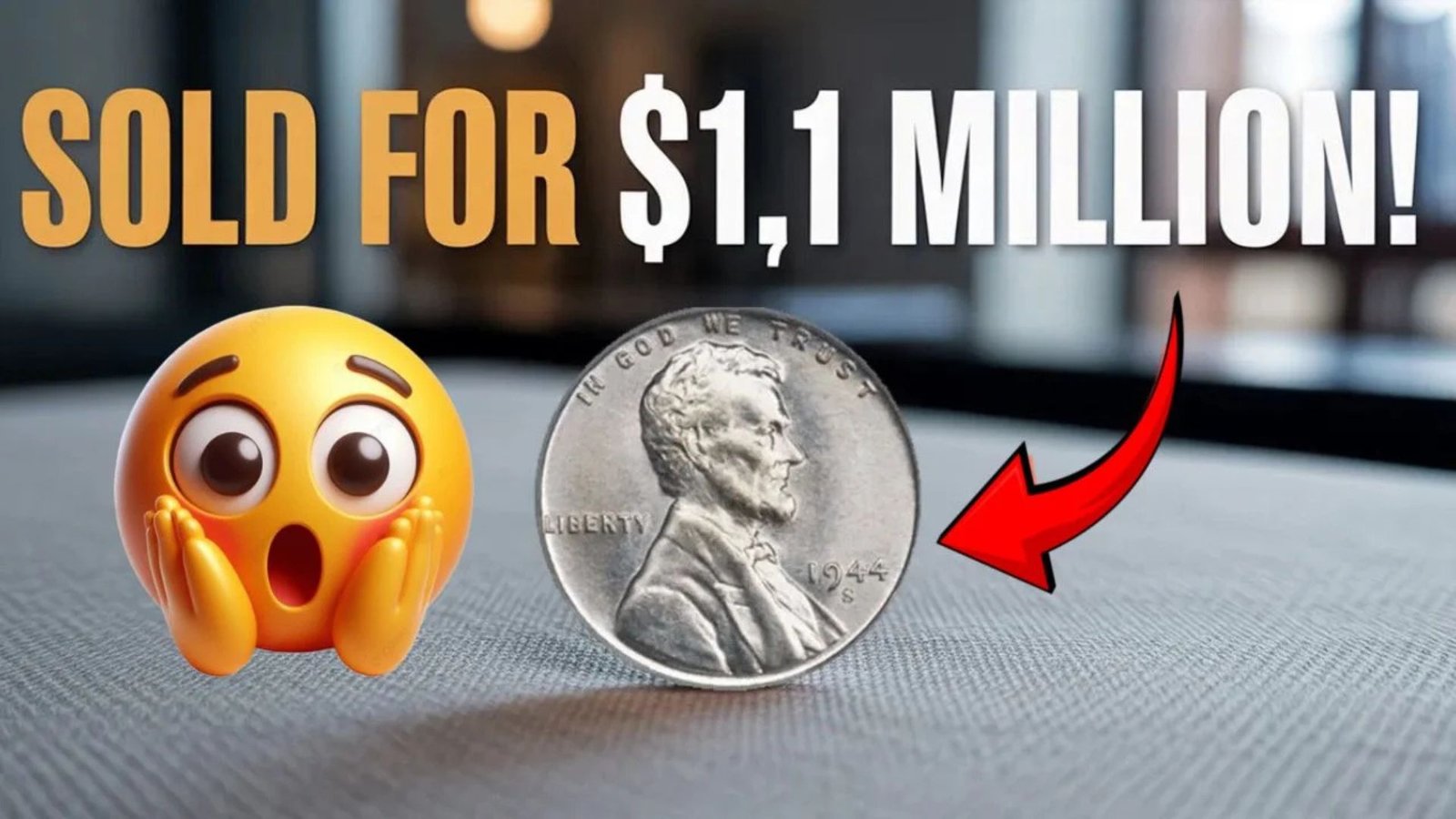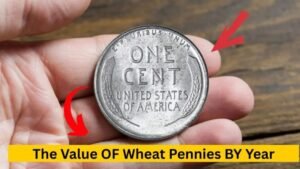In the world of coin collecting, few stories are as exciting as the 1944 Wheat Penny that fetched an incredible $1.1 million at auction. This small piece of history, originally worth just one cent, has become a legend among collectors due to its rarity and unique story. Let’s dive into the fascinating tale of this record-breaking coin, why it’s so valuable, and what makes it a treasure for numismatists (coin enthusiasts).
What Is the 1944 Wheat Penny?
The 1944 Wheat Penny is a U.S. one-cent coin minted in 1944, featuring Abraham Lincoln’s portrait on the front (obverse) and two wheat stalks on the back (reverse). Designed by Victor David Brenner, this penny was part of a series produced from 1909 to 1958. Most Wheat Pennies are common and worth only a few cents, but a rare version from 1944 stands out due to a unique error during its production.
Why Is the 1944 Wheat Penny So Special?
During World War II, copper was in high demand for military use, so the U.S. Mint made most 1944 pennies from steel coated with zinc to save copper. However, a tiny number of 1944 pennies were accidentally struck on copper planchets (blanks) left over from 1943 production. These “1944 copper errors” are incredibly rare and highly sought after by collectors.
One such penny, struck at the Denver Mint (marked with a “D” mintmark), became the star of the show. Its rarity, combined with its excellent condition, led to its record-breaking $1.1 million sale at a 2010 auction, making it one of the most valuable pennies ever sold.
The Journey to $1.1 Million
The Error That Made History
The 1944 Wheat Penny’s value comes from a minting mistake. In 1943, the U.S. Mint switched to steel pennies to conserve copper for the war effort. A few copper planchets, however, were mistakenly used in 1944, creating a small batch of copper pennies. The Denver Mint produced only a handful of these error coins, with estimates suggesting fewer than 30 exist today.
Discovery of the Million-Dollar Penny
The $1.1 million 1944-D Wheat Penny was discovered in the 1970s by a collector who noticed its unusual copper color. Unlike the common steel pennies of 1944, this coin stood out. After authentication by experts, it was confirmed as a genuine 1944-D copper error coin. Its pristine condition, graded as MS-63 (Mint State 63) by professional grading services, added to its value.
The Record-Breaking Auction
In 2010, this rare penny was auctioned by Heritage Auctions, a leading auction house for rare coins. Bidding started high, and excitement grew as collectors competed for the prize. When the gavel fell, the penny sold for an astonishing $1.1 million, setting a new record for a single penny. The buyer, a private collector, recognized its historical and monetary value.
Why Are 1944 Wheat Pennies So Valuable?
Several factors contribute to the jaw-dropping value of this 1944 Wheat Penny:
| Factor | Explanation |
|---|---|
| Rarity | Only a few 1944 copper pennies exist, with fewer than 30 known from the Denver Mint. |
| Minting Error | The accidental use of copper instead of steel makes these coins unique. |
| Condition | The $1.1 million penny was in near-perfect condition, graded MS-63. |
| Historical Significance | Minted during WWII, it reflects a unique moment in U.S. history. |
| Collector Demand | High demand from coin enthusiasts drives up prices at auctions. |
Rarity and Scarcity
With only a handful of 1944 copper pennies known to exist, their scarcity is a major driver of value. The Denver Mint’s error coins are particularly rare, as most 1944 pennies were made of steel.
Minting Error
The mistake of using copper planchets in 1944 created a coin that shouldn’t exist. These errors are prized in the collecting world because they’re one-of-a-kind accidents.
Condition and Grading
Coin condition is critical in determining value. The $1.1 million penny was graded MS-63, meaning it had minimal wear and retained much of its original shine. Coins in such excellent condition are rare, especially for error coins that may have circulated for years before being discovered.
Historical Context
The 1944 Wheat Penny was minted during World War II, a time when the U.S. was focused on conserving resources. The switch to steel pennies was a wartime measure, making the copper error coins a snapshot of that era.
How to Identify a Valuable 1944 Wheat Penny
If you’re wondering whether you have a million-dollar penny in your pocket, here’s what to look for:
- Material: Check if the penny is copper, not steel. Copper pennies are reddish-brown, while steel pennies are silver-gray.
- Mintmark: Look for a “D” (Denver) or “S” (San Francisco) under the year 1944. Philadelphia Mint pennies (no mintmark) are also rare but less valuable.
- Condition: The coin should have clear details with minimal scratches or wear.
- Authentication: Have the coin professionally graded by services like PCGS or NGC to confirm its authenticity.
Note: Always consult a professional numismatist before assuming a coin’s value. Most 1944 pennies are steel and worth only a few cents.
Other Notable 1944 Wheat Pennies
While the $1.1 million 1944-D penny is the most famous, other rare 1944 pennies exist:
- 1944-S Copper Penny: A copper penny from the San Francisco Mint sold for $408,000 in 1999.
- 1944 Philadelphia Penny: A copper penny without a mintmark fetched $373,750 in 2008.
- 1944 Steel Penny: Some 1944 pennies were mistakenly struck on steel planchets, making them valuable, though not as much as the copper errors.
Tips for Coin Collectors
If you’re inspired to start collecting coins, here are some tips to get started:
- Research: Learn about coin types, minting errors, and grading systems.
- Buy from Reputable Dealers: Purchase coins from trusted sources like Heritage Auctions or certified dealers.
- Store Properly: Keep coins in protective holders to preserve their condition.
- Join a Community: Connect with other collectors through clubs or online forums to share knowledge.
- Authenticate: Always verify rare coins with professional grading services.
The Legacy of the 1944 Wheat Penny
The $1.1 million 1944 Wheat Penny is more than just a coin—it’s a piece of history that captures the imagination of collectors worldwide. Its story reminds us that even small objects can hold immense value due to their rarity, history, and the passion of those who seek them. As coin collecting grows in popularity, the legend of this penny continues to inspire treasure hunters and enthusiasts alike.
Conclusion
The 1944 Wheat Penny that sold for $1.1 million is a testament to the thrill of coin collecting. Its rare copper composition, pristine condition, and historical significance made it a record-breaker in the numismatic world. Whether you’re a seasoned collector or just curious, this penny’s story shows how a simple cent can become a million-dollar treasure. Keep an eye on your change—you never know what hidden gem you might find!
FAQs About the 1944 Wheat Penny
1. Why is the 1944 Wheat Penny so valuable?
The 1944 Wheat Penny is valuable due to a rare minting error where a few pennies were struck on copper planchets instead of steel, combined with its excellent condition and historical significance.
2. How can I tell if my 1944 penny is copper or steel?
A copper penny is reddish-brown and non-magnetic, while a steel penny is silver-gray and magnetic. Use a magnet to test it.
3. Where can I get my 1944 penny appraised?
Contact professional grading services like PCGS (Professional Coin Grading Service) or NGC (Numismatic Guaranty Corporation) for an accurate appraisal.
4. Are all 1944 Wheat Pennies valuable?
No, most 1944 pennies are steel and worth only a few cents. Only the rare copper error coins from Denver or San Francisco are highly valuable.
5. How many 1944 copper pennies exist?
Fewer than 30 copper 1944 pennies are known to exist, with the Denver Mint’s being the rarest.
6. Can I find a valuable 1944 penny in circulation?
It’s highly unlikely, as most valuable 1944 pennies have been identified and collected. However, checking your change doesn’t hurt!





1 thought on “The 1944 Wheat Penny That Broke All Records at $1.1 Million”